
August 2010
John Vincent Bellezza
Fourth anniversary issue
Welcome to the 49th issue of Flight of the Khyung! Very glad you can see it. This month’s offering comes out later than usual due to fieldwork in Tibet. I have just completed the Upper Tibetan Rock Art Expedition (UTRAE), a highly focused mission to digitally photograph rock art and reconnoiter undocumented archaeological sites across upland Tibet. Despite just 37 days in the field, I was able to chart ancient fortresses, necropoli and rock art unknown to modern scholarship, taking more than 7000 photographs in the process. Additionally, the expedition documented a type of burial in wooden coffins particular to the Montsher (Mon-’tsher) region of southwestern Tibet as well as two ancient Bon religious centers in Lhatse (Lha-rtse) in Central Tibet. So there is much to share with you this month and in the issues to follow. Let us begin with what I believe to be a very significant discovery.
Riding high: the chariots of ancient Upper Tibet
On the UTRAE, I happened upon a variety of carvings of chariots in western Tibet, with huge implications for the historico-cultural development of Upper Tibet. It has long been known that in the second and first millennia BCE, the production and use of chariots in war, ceremonies and contests stretched from the Mediterranean to China. Ancient military elites adopted this technological innovation with much vigor, greatly elevating their stature in the eyes of both compatriots and enemies. Upper Tibet of this timeframe was not left out of the game; it too knew of the chariot, not as something foreign or exotic, but as an integral part of its culture and society. No single shred of archaeological evidence more potently underscores the Tibetan Plateau’s vigorous participation in the cultural life of ancient Eurasia.
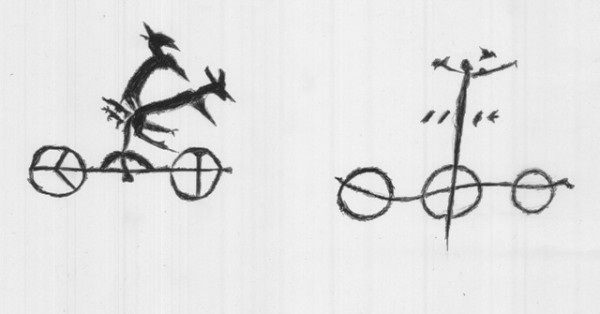
The first inkling that at least a portion of the Upper Tibetan population knew of the chariot or two-wheeled wagon came with their discovery in the rock art tableau of the central Changthang by an art historian at Tibet University named Lobsang Tashi. In 2002, he published a short paper describing two chariot petroglyphs he found at two different rock art sites (with the inclusion of line drawings of them). One specimen depicts a vehicle with cross-shaped wheels being pulled by what appear to be two horses. The other more ambiguously rendered specimen shows three bisected circular forms along the axle. The middle circle, the body, box or basket, sits upon the central pole ending in objects that seem to represent draught horses. Lobsang Tashi compares these chariots with those from the Qinghai sites of Lushan and Yeniugou, and dates the Upper Tibetan specimens rather expansively to 1000 BCE to 600 CE.
In their book on the rock art of Qinghai (Qinghai Yanhua: Beijing, 2001), Tang Huisheng and Zhang Wenhua suggest that chariots with wheels of four-spokes found at the Yeniugou and Shebuqi rock art sites were primarily used between the Shang and Warring States periods, to use Chinese chronological terminology. They date similar chariot petroglyphs of the Heishan site, in Gansu, to circa 1000 BCE. On the other hand, Tang Huisheng and Zhang Wenhua believe that the three petroglyphs of chariots at the well-known Lushan grotto should be dated to the last third of the first millennium BCE, as they were engraved in perspective and have a more refined appearance and because of their similarity to chariots rendered on Qin and Han tablets. Chariot petroglyphs and many other archaeological assets of Qinghai have close affinities with Bronze Age Inner Asian cultures and in historic times with cultures of the Silk Road. Most of Bronze Age and Iron Age Qinghai appears to have been an integral part of the north Inner Asian cultural world, but with an admixture of Bodic cultural features (the strength of which is still not very clear).
Petroglyphs of comparable chariots are known throughout Inner Asia and the Upper Indus. They are generally dated by rock art specialists (using inferential means) to the second millennium BCE. In the heart of Asia, rudimentary carts along with bronze-making technology appear to have been pioneered by the Afanasievo cultures in the late third millennium BCE. The first fully developed chariots in the steppes belong to burials of the Sintashta-Petrovka cultural cluster of the upper Ural basin, part and parcel of the Andronovo, an interrelated group of cultural systems that arose in the steppes. It is commonly speculated that the Andronovo consisted of speakers of various Indo-Iranian languages. These chariots of the Sintashta, complete with multi-spoked wheels, have been dated to circa 2000 BCE. According to archaeologists such as E. Kuzmina, bronze technology and chariots reached Eastern Turkestan with the southward and eastward movements of the Andronovo tribes, beginning in the 15th to 13th century BCE.
The appearance of chariots in regions adjoining Upper Tibet by the late second millennium BCE provides a potential vector of transmission to the Plateau. Yet until now, this link seemed quite hypothetical to me. While Lobsang Tashi’s discovery of two chariot carvings in the middle of the Changthang is extremely significant, I could not be certain they were not merely a one-off, a bit of exotica known to only a select group of ancient Upper Tibetan society (the implications of his chariot finds are discussed in my book Zhang Zhang, pp. 195-96). The ostensible rarity of the motif, I suggested, indicates that animal-drawn carts were not produced in the region with any degree of regularity. I thought it plausible that chariot petroglyphs may have been inspired by individuals who traveled between the steppes and the high Plateau as part of economic, military and/or cultural associations, bringing knowledge of technological developments in transportation with them. With my new finds, however, it is now clear that chariots in Upper Tibet were much more than a mere curiosity.
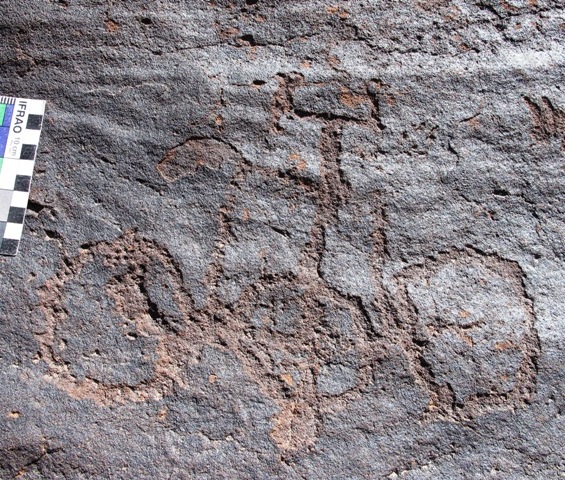
A chariot petroglyph in the western Changthang
In the western Changthang, at a large rock art theatre I first documented a decade ago, a lone chariot has come to light (it escaped detection during my 2000 survey). It is situated on the south edge of the site on a particularly large boulder at 4730 m in elevation. On the moderately inclined top of this boulder with its southwest aspect there are around 25 ungulates (including yaks). Some of these ungulates are arrayed in two rows, each of which is being confronted by a carnivore. There may also be two horsemen on this panel, but they are highly worn and ambiguously depicted (there are many mounted hunters at the site). The chariot carving is situated on the lower north corner of the boulder top. It exhibits a circular box within which crossed lines were placed and simple circles as wheels along the same axis. The central pole, yokes and what appear to be the reins were also carved. This chariot, however, is depicted without draught animals.
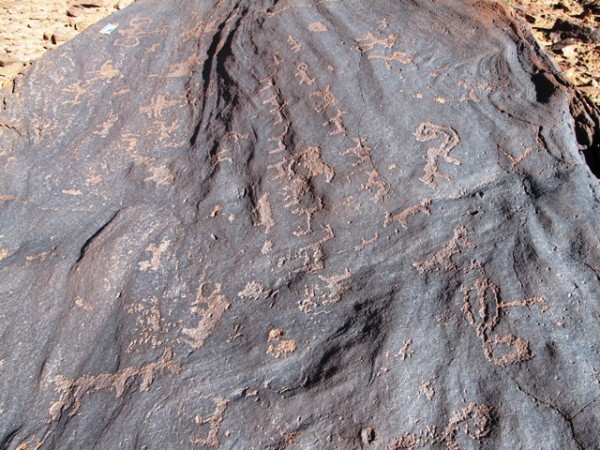
Boulder with chariot (upper left corner)
The isolated location of the boulder with the chariot at the extreme southeastern fringe of the site combined with the sheer number of carvings upon it seems to point to a special prominence. This boulder is in close proximity to the remains of what appear to be funerary superstructures, and it is the only boulder of more than 100 with carvings at the site that portrays a chariot, adding to its overall significance. The ungulates engraved on the same rock panel are in styles typical of Upper Tibet, the yak and wild ass (rkyang) being most dominant among them.
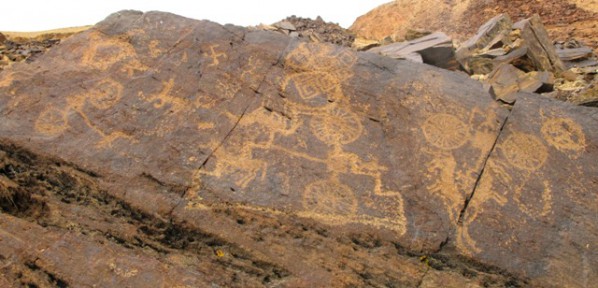
Two highly detailed chariots and a simpler specimen.
Further west, at the threshold to the Tibetan badlands, I located an entire gallery of chariots, indicating that this conveyance and status symbol was known to considerable numbers of people. I documented more than a dozen chariots in various styles and states of preservation, the product of different hands carving over generations. On top of one large, steeply inclined boulder with a southern aspect are various complex scenes, which include two chariots of exceptionally fine detail. This boulder is located in close proximity to a ruined all-stone corbelled residence (rdo-khang) belonging to the archaic cultural horizon. The creation of at least some of the petroglyphs at the site must coincide with the occupation of this permanent residence. This type of all-stone structure is extremely robust and potentially may have been occupied for centuries.
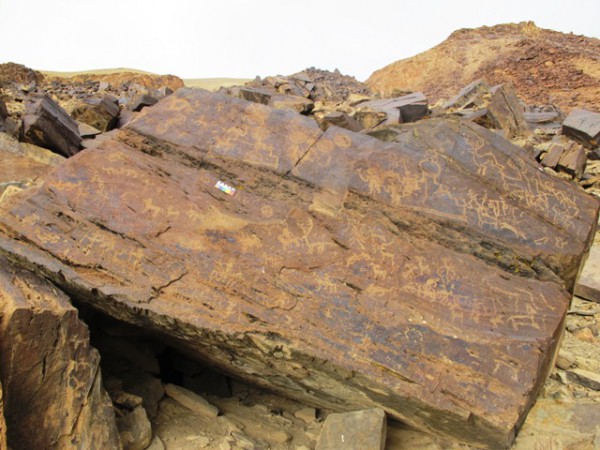
A boulder with three chariots in far western Tibet
In addition to the chariots, the boulder in question includes a bevy of anthropomorphic and zoomorphic figures. The number and diversity of carvings indicates that it was the focus of special attention and care. Two distinct periods of petrogylphs are discernible on this one boulder: 1) prehistoric chariots and anthropomorphic and zoomorphic compositions, including three different scenes of carnivores attacking and devouring what appear to be ungulates; 2) two early historic period chortens and one mani mantra. The relative age of some compositions is evidenced in palimpsests. The particular set of images chosen to ornament the boulder top is of the kind regularly associated with Upper Tibetan rock art. The chariots being embedded among such motifs signals their place in the archaic mytho-ritual complex of the region.
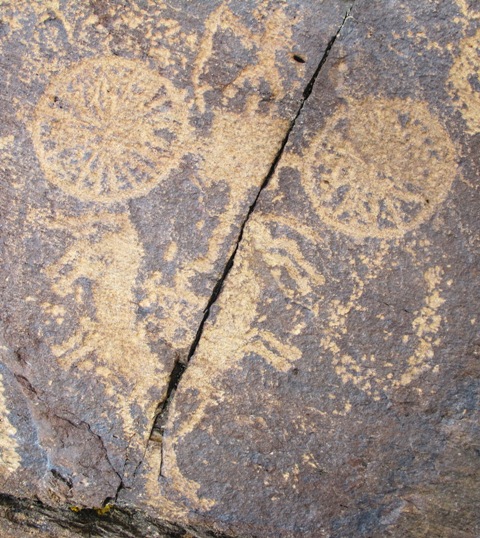
A dramatic rendition of a chariot complete with charioteer
Three chariots including the two technically refined specimens are located on the upper left side of the boulder (situated at 4340 m). In the carving on the right all the major components of a chariot are clearly depicted. The charioteer holds a long object in his left hand; this may represent the reins. The multi-spoked wheels places this Upper Tibetan variant among the chariots types of central and east Asia. Like the rest of the carving, the halter assembly is intricately presented, its various parts including the collar bands discernible. The chariot box seems only large enough for the driver; this is clearly a war and/or ceremonial vehicle, not a cart for cargo. The driver appears to have three protuberances on his head, a common embellishment in Upper Tibetan anthropomorphous rock art. This probable headdress accoutrement may have consisted of feathers or horns (both are well attested to in Tibetan textual descriptions of pre-Buddhist luminaries).
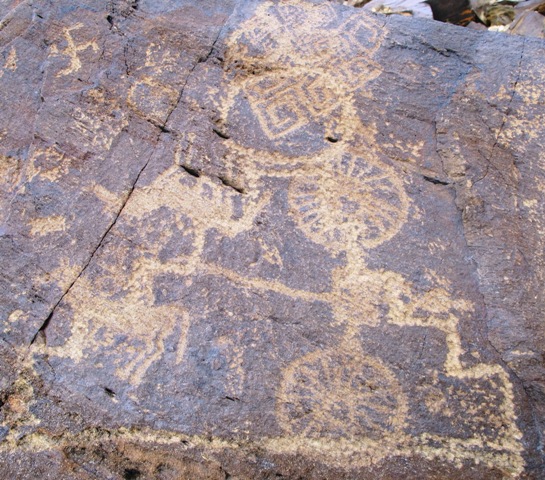
The other adeptly carved chariot upon which a chorten has been carved
The other beautifully carved chariot exhibits the same major technical elements as its companion. It too is shown with the driver placed in the box. We can imagine that these vehicles were envisioned by their makers as racing across the plains in a show of force and skill. A chorten of the early historic period (600–1000 CE) was carved right over the chariot, perhaps with the intention of neutralizing or suppressing archaic sanguinary or ritual connotations. The chorten itself is quite well repatinated and has four tiers upon which a small round bum-pa has been placed. The finial of the chorten is comprised of three circular structures. The bumpa and finial were carved on top of a geometric pattern of the type I have observed on Tibetan bronze objects of the thog-lcags class.
For the benefit of my readers, images of six other chariots found on some of the 200 boulders of the same rock art site are displayed below. These provide a wide representative sample of the ways in which this conveyance was viewed among rock carvers whose cultural universe included wheeled vehicles.

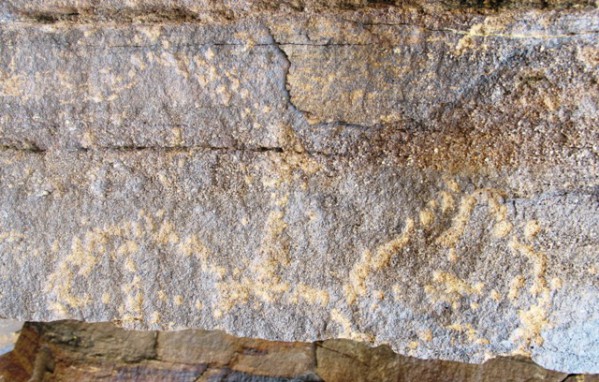
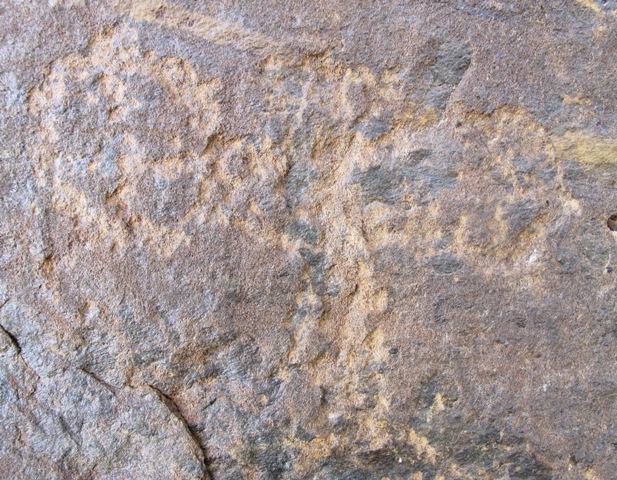
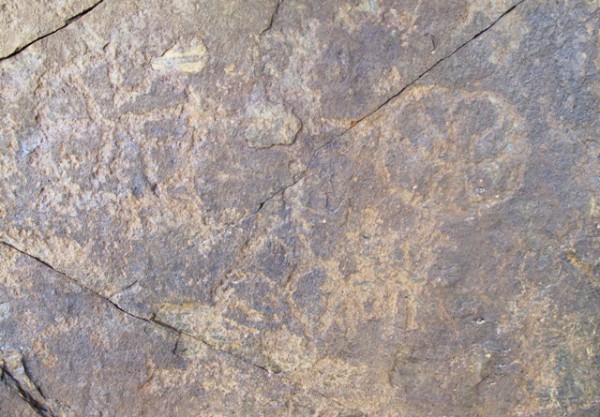
We now know that chariots were part of the rock art of not just Changthang but the lower elevation valleys of far western Tibet as well, expanding their range across most of Upper Tibet. To date, they have not been documented in the rock art of the eastern Changthang. The wide geographic distribution of chariot petroglyphs speaks of the technological importance of this conveyance to ancient Upper Tibetans. More importantly, the manner in which this vehicle is depicted in association with common figures and symbols of the Upper Tibetan rock art tableau indicates that it is not a marginal or alien feature, but an integral part of the ancient narratives of the inhabitants. The swastika and sun symbols found in conjunction with the chariot indicate its assimilation into zeitgeist of the region as part of its mytho-religious complex. The hunting scenes of wild yaks and other ungulates found in close proximity to some chariot petroglyphs allude to the heroic aura surrounding this mode of transport as well.
At this juncture in my research, the chronology of the chariot carvings of Upper Tibet can only be inferred, as chronometric techniques for dating rock art are still in the process of being perfected. Chariots as an effective instrument of war in Eurasia were superseded by cavalry horses in the 4th and 3rd centuries BCE. Once horses had been bred large enough to mount, their superior speed and maneuverability rendered the chariot tactically obsolete. Take the celebrated example of Alexander the Great’s rout of Darius III at the Battle of Gaugamela in 331 BCE. Darius’ chariots proved no match for the nimble riding horses of Alexander. Chariots continued to be used in the Classical world in sport and ceremony until the fall of the Roman empire and even beyond this time in Constantinople. In China after the Warring States period chariots fell out of favor as an instrument of war, but were employed by dignitaries of the Han dynasty as a means of transport.
Chariots in India are first recorded in the Rig Veda, a text that in its essential form is often dated to the second millennium BCE. Chariots are a very important mythic theme in the Rig Veda, the vehicle of the gods and symbol of the sun. It is commonly theorized that chariots were introduced into the Indian Subcontinent by Indo-Iranian migrants in the second millennium BCE (Indian rock art is an important pillar of this theoretical stance; for possible Indo-European mythic elements in the pantheon of Upper Tibet, see Zhang Zhung, pp. 300–342). In China, the famous chariot burials at An-yang prove that it had moved to the center of that country by 1200 BCE (some archaeologists believe the chariot was introduced into China circa 1700 BCE, but the physical evidence adducing such an early date is debatable).
By the late second millennium BCE, chariots south of the Himalaya and far to the east in China were a standard part of elite cultural life. An even earlier date can be postulated for certain regions in north Inner Asia, Mongolia among them. We have therefore an ancient world in which peoples of the chariot circumscribed the Tibetan Plateau. The chariot’s date of penetration into Upper Tibet cannot yet be gauged with any surety, but for the sake of initiating a debate I will suggest that they reached Upper Tibet circa 1500 to 800 BCE. As for the age of the chariot petroglyphs I have documented, their production can probably be assigned to a period predating the fourth century BCE, the close of the era of the chariot as a prime political and military symbol in Eurasia. There would hardly be any cause for its absorption into the Upper Tibetan cultural matrix after this time. We might argue that technically proficient examples of Upper Tibetan chariots were carved later than the simpler and more abstract ones, but this remains to be conclusively shown.
The most crucial aspect of the chariot in Upper Tibetan rock art is that it reveals a late Bronze Age/Iron Age culture that was firmly in the Inner Asian pan-cultural orbit. Needless to say, the implications of this historical reality to the cultural origins and evolution of Upper Tibet are enormous. Nonetheless, the empirical and theoretical data needed to fathom the full significance of Tibet’s chariots must now be harnessed by experts in a variety of disciplines.
A quick word on Central Tibet: although there is not a well developed rock art tradition in this region, there is no reason to believe that she did not know the chariot as well. In any case, both early Upper Tibet (which came to be known as Zhang Zhung and Sumpa) and Central Tibet (traditionally known as sPu-rgyal bod) formed the heartland of what became a more or less fully integrated Tibetan cultural complex by 1000 CE (for a historical discussion of Tibet’s cultural core, see my forthcoming paper in the October issue of the online journal Revue d’Etudes Tibétaines).
Next month: more exciting archaeological discoveries from the UTRAE!